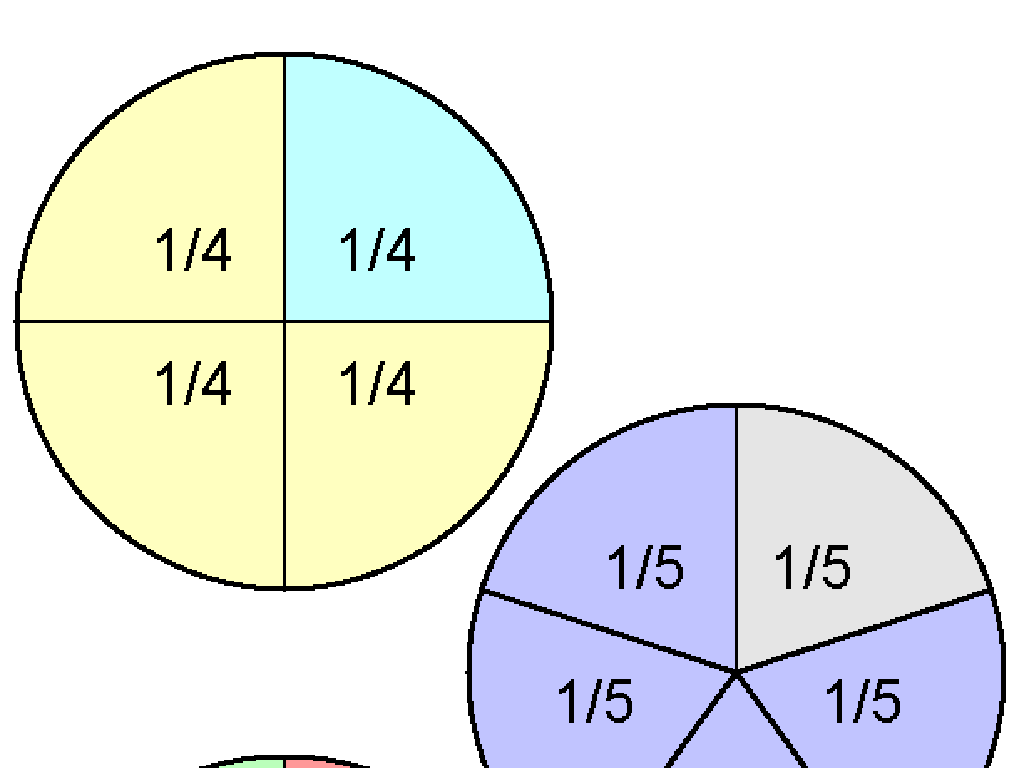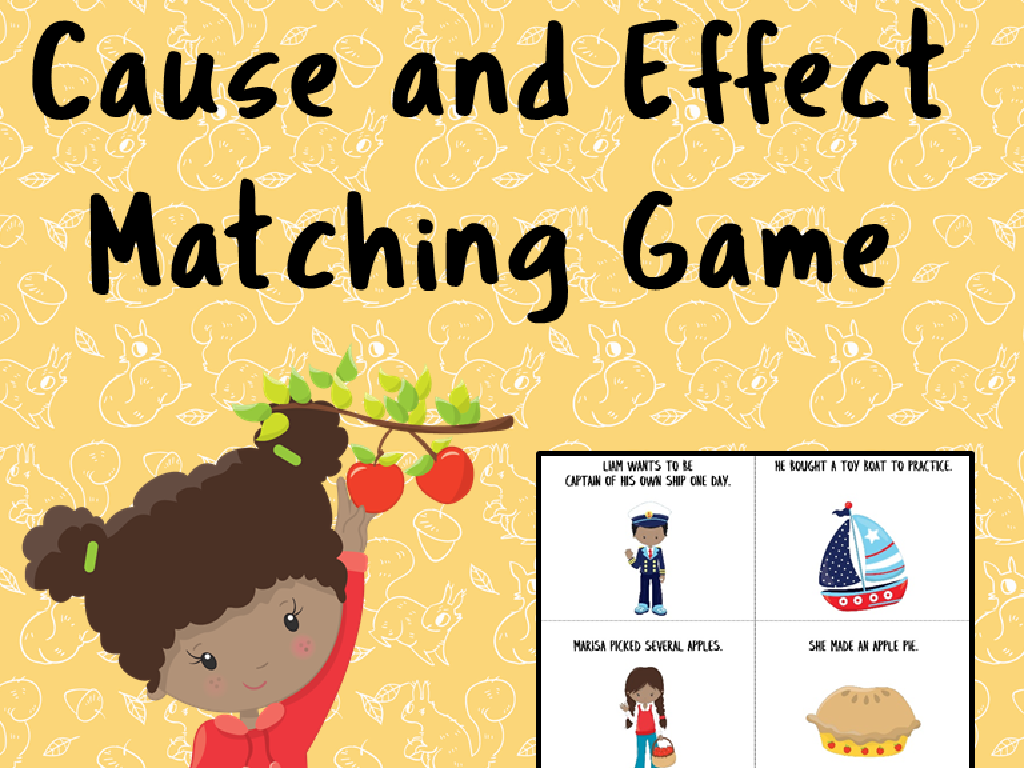Classify Symbiotic Relationships
Subject: Science
Grade: Sixth grade
Topic: Ecological Interactions
Please LOG IN to download the presentation. Access is available to registered users only.
View More Content
Exploring Symbiotic Relationships
– Organisms interact in their habitats
– Introduction to symbiosis
– Symbiosis: close, long-term interaction between species
– Types of symbiotic relationships
– Mutualism, Commensalism, Parasitism
– Symbiosis maintains ecosystem balance
– Healthy symbiosis is crucial for stable ecosystems
|
This slide introduces the concept of symbiotic relationships within ecological interactions. Start by discussing how organisms do not exist in isolation but interact with each other and their environment in various ways. Introduce the term ‘symbiosis’ as a close and often long-term biological interaction between two different biological organisms. Highlight the three main types of symbiotic relationships: mutualism (both benefit), commensalism (one benefits, the other is unharmed), and parasitism (one benefits at the expense of the other). Emphasize the importance of these interactions in maintaining the balance of ecosystems. Encourage students to think of examples they may already know and prepare to delve deeper into each type in the following slides.
Exploring Symbiosis in Nature
– Define symbiosis
– Symbiosis: a close, long-term interaction between different species.
– Symbiosis in ecosystems
– These relationships are crucial for the survival of many organisms and the health of ecosystems.
– Everyday examples of symbiosis
– Examples: Bees pollinating flowers, birds eating ticks off cattle.
– Impact on natural balance
– Symbiotic relationships can affect population control and resource distribution.
|
This slide introduces the concept of symbiosis, a fundamental ecological interaction where different species live in close association with each other. Emphasize the importance of symbiotic relationships in maintaining the balance of ecosystems. Provide relatable examples such as pollination by bees, which is essential for plant reproduction, and birds that eat parasites off larger animals, keeping them healthy. Discuss how these interactions can control populations and distribute resources, which in turn affects the entire ecosystem. Encourage students to think of other examples they may have observed in nature or at home, like pets and their owners.
Types of Symbiotic Relationships
– Mutualism: both benefit
– Example: Bees and flowers. Bees get nectar, flowers get pollinated.
– Commensalism: one benefits, one unaffected
– Example: Barnacles on whales. Barnacles get transport, whales aren’t bothered.
– Parasitism: one benefits, one harmed
– Example: Ticks on dogs. Ticks get blood, dogs may get diseases.
|
This slide introduces students to the concept of symbiotic relationships within ecosystems. Mutualism is a win-win situation where both organisms benefit, such as bees and flowers. Commensalism involves one organism benefiting while the other is neither helped nor harmed, like barnacles that attach to whales. Parasitism is a relationship where one organism benefits at the expense of the other, such as ticks feeding on a dog. Encourage students to think of other examples and discuss how these relationships affect the balance of ecosystems. This understanding is crucial for their grasp of ecological interactions and the interdependence of life.
Mutualism: A Win-Win Symbiotic Relationship
– Mutualism as a win-win scenario
– Both species involved in mutualism gain benefits crucial for survival.
– Case study: Bees and flowering plants
– Bees get nectar for food; plants get help with pollination.
– Benefits for both organisms
– Bees gain energy; plants reproduce through pollination.
– Significance in ecosystems
|
This slide delves into the concept of mutualism, a type of symbiotic relationship where both organisms involved benefit and support each other’s survival. A classic example is the relationship between bees and flowering plants. Bees collect nectar from the flowers to make honey, which is their food source. In the process, they inadvertently carry pollen from one flower to another, aiding in plant reproduction. This interaction is vital for the ecosystem as it supports the continuation of plant species and provides food for the bees. Encourage students to think of other mutualistic relationships and how they contribute to a balanced ecosystem. This understanding will help them appreciate the interconnectedness of life forms on Earth.
Commensalism in Depth
– What is commensalism?
– A relationship where one organism benefits, the other is unharmed
– Birds nesting in trees case study
– Birds benefit by safety, trees are not harmed or helped
– Identify the beneficiary
– The organism that gains from the relationship
– Recognize the unaffected party
– The organism that is neither helped nor harmed
|
Commensalism is a type of symbiotic relationship where one organism benefits while the other is neither helped nor harmed. An example to illustrate this is birds nesting in trees. The birds gain a safe place to live and raise their young (beneficiary), while the trees do not gain or lose anything (unaffected party). During the presentation, emphasize the importance of recognizing both parties in a commensal relationship. Encourage students to think of other examples and to discuss how one party benefits while the other remains neutral. This will help them understand the concept of commensalism and its role in ecological interactions.
Parasitism: A Symbiotic Relationship
– Understanding parasitism
– Parasitism benefits one organism at the expense of another
– Case study: Animal ticks
– Ticks attach to animals, drawing blood for nourishment
– Effects on hosts
– Hosts may suffer from blood loss and disease
– Parasite benefits & host harm
– While ticks thrive, hosts can experience health decline
|
This slide delves into the concept of parasitism, one of the three main types of symbiotic relationships. Parasitism is characterized by one organism, the parasite, benefiting at the expense of the host. Using ticks as a case study provides a concrete example for students, illustrating how ticks feed on the blood of animals and can transmit diseases. Discuss the negative impacts on the host, such as blood loss, irritation, and potential infection, while highlighting that the parasite’s survival and reproduction are dependent on this relationship. Encourage students to think critically about the balance of ecosystems and the complex interactions between different species.
Classifying Symbiotic Relationships
– Identifying symbiosis types
– Look for interactions where both species benefit, one benefits and the other is unharmed, or one benefits at the other’s expense.
– Mutualism characteristics
– Both species benefit, e.g., bees and flowers.
– Commensalism features
– One species benefits, the other is unharmed, e.g., barnacles on whales.
– Parasitism traits
– One species benefits at the expense of the other, e.g., ticks on a dog.
|
This slide aims to help students understand and identify the three main types of symbiotic relationships: mutualism, commensalism, and parasitism. Start by explaining symbiosis as a close ecological interaction between two different species. Then, describe each type with key characteristics: mutualism involves both species benefiting, commensalism involves one species benefiting without affecting the other, and parasitism involves one species benefiting at the expense of the other. Provide interactive examples for each type and ask students to classify them, reinforcing their understanding of the concepts. Encourage students to think of additional examples and discuss why they fit into each category.
Class Activity: Exploring Symbiosis
– Review symbiotic relationship types
– Classify scenarios in groups
– Determine if it’s mutualism, commensalism, or parasitism
– Discuss each group’s classification
– Share your group’s thoughts and reasoning
– Present findings to the class
– Explain why you classified the scenarios as you did
|
This activity is designed to help students apply their knowledge of symbiotic relationships by classifying different ecological interactions. Break the class into small groups and provide each with a set of scenarios that depict various interactions between organisms. Students will discuss within their groups to determine whether each scenario represents mutualism, commensalism, or parasitism. After the group discussion, each group will present their findings and the reasoning behind their classifications to the rest of the class. This will not only help in reinforcing their understanding of the concepts but also develop their communication and critical thinking skills. Possible scenarios could include a bee and a flower, a shark and remoras, or a dog and fleas. Encourage students to justify their answers based on the characteristics of each symbiotic relationship.
Conclusion: Symbiotic Relationships
– Review: 3 symbiotic types
– Mutualism, Commensalism, Parasitism
– Importance in ecosystems
– They ensure species survival and ecological stability
– Q&A session
– Clarify doubts and solidify understanding
|
As we wrap up, revisit the three main types of symbiotic relationships: mutualism, where both species benefit; commensalism, where one benefits without harming the other; and parasitism, where one benefits at the expense of the other. Emphasize how these interactions are crucial for the balance and health of ecosystems, as they can affect population dynamics, community structure, and the flow of energy. During the Q&A session, encourage students to ask questions to clear up any confusion and to provide examples to help them better grasp the concepts. This will help ensure they have a solid understanding of how symbiotic relationships contribute to ecological interactions and the importance of biodiversity.





